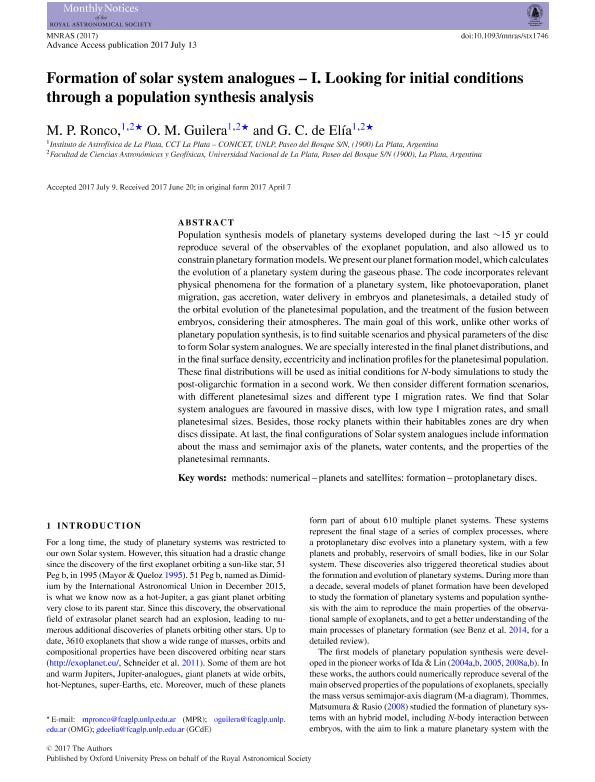Mostrar el registro sencillo del ítem
dc.contributor.author
Ronco, María Paula

dc.contributor.author
Guilera, Octavio Miguel

dc.contributor.author
de Elia, Gonzalo Carlos

dc.date.available
2021-10-28T18:51:17Z
dc.date.issued
2017-11
dc.identifier.citation
Ronco, María Paula; Guilera, Octavio Miguel; de Elia, Gonzalo Carlos; Formation of solar system analogues - I. Looking for initial conditions through a population synthesis analysis; Oxford University Press; Monthly Notices of the Royal Astronomical Society; 471; 3; 11-2017; 2753-2770
dc.identifier.issn
0035-8711
dc.identifier.uri
http://hdl.handle.net/11336/145398
dc.description.abstract
Population synthesis models of planetary systems developed during the last ~15 yr could reproduce several of the observables of the exoplanet population, and also allowed us to constrain planetary formation models. We present our planet formation model, which calculates the evolution of a planetary system during the gaseous phase. The code incorporates relevant physical phenomena for the formation of a planetary system, like photoevaporation, planet migration, gas accretion, water delivery in embryos and planetesimals, a detailed study of the orbital evolution of the planetesimal population, and the treatment of the fusion between embryos, considering their atmospheres. The main goal of this work, unlike other works of planetary population synthesis, is to find suitable scenarios and physical parameters of the disc to form Solar system analogues. We are specially interested in the final planet distributions, and in the final surface density, eccentricity and inclination profiles for the planetesimal population. These final distributions will be used as initial conditions for N-body simulations to study the post-oligarchic formation in a second work. We then consider different formation scenarios, with different planetesimal sizes and different type I migration rates. We find that Solar system analogues are favoured in massive discs, with low type I migration rates, and small planetesimal sizes. Besides, those rocky planets within their habitables zones are dry when discs dissipate. At last, the final configurations of Solar system analogues include information about the mass and semimajor axis of the planets, water contents, and the properties of the planetesimal remnants.
dc.format
application/pdf
dc.language.iso
eng
dc.publisher
Oxford University Press

dc.rights
info:eu-repo/semantics/openAccess
dc.rights.uri
https://creativecommons.org/licenses/by-nc-sa/2.5/ar/
dc.subject
METHODS: NUMERICAL
dc.subject
PLANETS AND SATELLITES: FORMATION
dc.subject
PROTOPLANETARY DISCS
dc.subject.classification
Astronomía

dc.subject.classification
Ciencias Físicas

dc.subject.classification
CIENCIAS NATURALES Y EXACTAS

dc.title
Formation of solar system analogues - I. Looking for initial conditions through a population synthesis analysis
dc.type
info:eu-repo/semantics/article
dc.type
info:ar-repo/semantics/artículo
dc.type
info:eu-repo/semantics/publishedVersion
dc.date.updated
2021-08-23T15:19:52Z
dc.identifier.eissn
1365-2966
dc.journal.volume
471
dc.journal.number
3
dc.journal.pagination
2753-2770
dc.journal.pais
Reino Unido

dc.journal.ciudad
Oxford
dc.description.fil
Fil: Ronco, María Paula. Consejo Nacional de Investigaciones Científicas y Técnicas. Centro Científico Tecnológico Conicet - La Plata. Instituto de Astrofísica La Plata. Universidad Nacional de La Plata. Facultad de Ciencias Astronómicas y Geofísicas. Instituto de Astrofísica La Plata; Argentina
dc.description.fil
Fil: Guilera, Octavio Miguel. Consejo Nacional de Investigaciones Científicas y Técnicas. Centro Científico Tecnológico Conicet - La Plata. Instituto de Astrofísica La Plata. Universidad Nacional de La Plata. Facultad de Ciencias Astronómicas y Geofísicas. Instituto de Astrofísica La Plata; Argentina
dc.description.fil
Fil: de Elia, Gonzalo Carlos. Consejo Nacional de Investigaciones Científicas y Técnicas. Centro Científico Tecnológico Conicet - La Plata. Instituto de Astrofísica La Plata. Universidad Nacional de La Plata. Facultad de Ciencias Astronómicas y Geofísicas. Instituto de Astrofísica La Plata; Argentina
dc.journal.title
Monthly Notices of the Royal Astronomical Society

dc.relation.alternativeid
info:eu-repo/semantics/altIdentifier/doi/http://dx.doi.org/10.1093/mnras/stx1746
dc.relation.alternativeid
info:eu-repo/semantics/altIdentifier/url/https://academic.oup.com/mnras/article/471/3/2753/3964549
Archivos asociados
